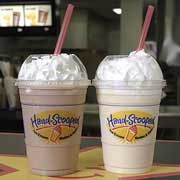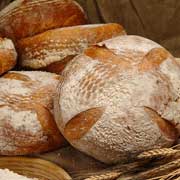Vol. V, No. 4, May 2005
- Editor's Corner
- Twentysomethings = the flavor generation
- Too much edu and not enough tainment: back to the future
- Reinventing bowling
- The first thing we need to do is kill all the accountants
- The ultimate lock-in
- Silverlake Family Recreation Center renovation
- 'Artisan' and 'handcrafted' a major food trend
- Chicago's Foundations Entertainment University a great success: July's is just around the corner
- The difference between the genders
- Agritainment Today e-newsletter coming
- Airlines with the most satisfied customers are the winners
- Motivating Generation Y workers
- BRC Imagination Arts recognizes Lincoln Presidential Library & Museum contributors
'Artisan' and 'handcrafted' a major food trend
CKE Restaurants, owners of the Hardee's and Carl's Jr. chains, are converting both chain restaurants, totaling more than 2,800 units, from machine-dispensed to handmade milkshakes. The company will offer hand-scooped ice cream shakes and malts mixed in blenders in vanilla, chocolate, strawberry and peach and will use 12% butterfat ice cream in lieu of the 3.5% butterfat ice milk used in premixed soft-serve milkshake machines. The shakes sell for $2.49, a $1 increase over the previous $1.49 price. "I'd rather pay $2.49 for something I really like than $1.49 for something I don't," said CKE Chief Executive Andy Puzder.

Hardee's and Carl's Jr. are launching premium Hand-Scooped Ice Cream Shakes and Malts
Many of the Hardee's and Carl's Jr. restaurants that have already switched over to the new hand-dipped shakes have seen shake sales double.
CKE's move may be partially in response to Shake & Steak's recent marketing campaign about their handcrafted and dual milkshakes. However, we don't believe that is the driving force behind the move, as Shake 'n Steak is a sit-down wait service chain, whereas both Hardee's and Carl's Jr. are fast food chains and not in direct competition. Rather, we see it as part of a larger trend to offer restaurant customers in all restaurant segments - including fast food, casual dining and fine dining - fresh, higher quality and more handcrafted (sometimes called artisan) food selections. The trend probably got its start with Starbuck's, where every drink is handcrafted with some showmanship. It grew to launch a whole new restaurant category known as fast-casual, of which Panera Bread is the leader. Panera offers fresh artisan breads and handcrafted sandwiches and salads, made with high-quality fresh ingredients. As a result, the chain commands a higher price point and their units are generating higher sales than fast food establishments, even though they don't have a drive-up window. Fast food restaurants do as much as 60% of their business from the drive-up lane.
 The
fast food chains have been pursuing the higher quality movement, with
McDonald's salads being one of many recent examples. Now
it is only logical that the handcrafted concept is working its way down
from the fast casual and fancier restaurant segments into the fast food
chains. Customers' expectations have been raised and fast food companies
need to raise the bar to keep from losing market share.
The
fast food chains have been pursuing the higher quality movement, with
McDonald's salads being one of many recent examples. Now
it is only logical that the handcrafted concept is working its way down
from the fast casual and fancier restaurant segments into the fast food
chains. Customers' expectations have been raised and fast food companies
need to raise the bar to keep from losing market share.
So what is the significance of this to location-based entertainment (LBE)
facilities? It's real simple. The bar for food quality and presentation
is rapidly rising throughout the restaurant industry, and with it, guests'
expectations. As regular readers of this eNewsletter know, our
research shows that success with community-based LBEs is highly dependent
upon food, and food that creates a dining destination. LBEs need to offer
food service that meets, if not exceeds, guests' expectations, based
upon eating and dining experiences guests have with the many restaurants
they frequent, including fast food restaurants.
Vol. V, No. 4, May 2005
- Editor's Corner
- Twentysomethings = the flavor generation
- Too much edu and not enough tainment: back to the future
- Reinventing bowling
- The first thing we need to do is kill all the accountants
- The ultimate lock-in
- Silverlake Family Recreation Center renovation
- 'Artisan' and 'handcrafted' a major food trend
- Chicago's Foundations Entertainment University a great success: July's is just around the corner
- The difference between the genders
- Agritainment Today e-newsletter coming
- Airlines with the most satisfied customers are the winners
- Motivating Generation Y workers
- BRC Imagination Arts recognizes Lincoln Presidential Library & Museum contributors


